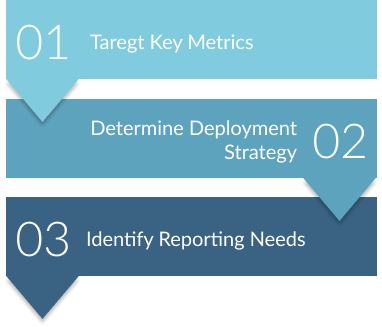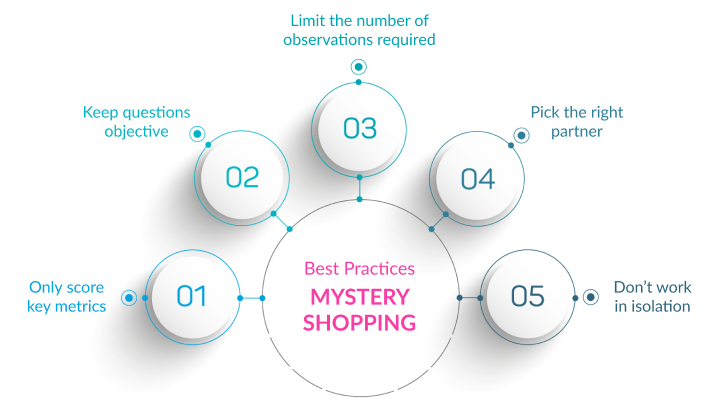Mystery Shopping
An Essential Guide to monitoring and measuring the execution of your customer experience and brand standards though mystery shopping.
It’s human nature to act differently when we know we’re being observed. We immediately become more aware of small details we otherwise don’t think about such as where to place our hands or what facial expression we should be making. This leads to us presenting a more calculated and polished version of ourselves.
But a better baseline is who we are when we aren’t being observed - or at least don’t know that we are. This is the basic principle behind mystery shopping. Mystery shoppers, also referred to as secret or covert shoppers, engage with your business under the guise of being an everyday customer while in fact are observing targeted aspects of your operations and brand experience.
Here we’ll start by explaining what we mean when we talk about mystery shopping as well as explore the benefits, methods, design and execution of mystery shopping programs so you can make informed decisions - whether you’re drafting your first shopper questionnaire or fine tuning an existing program.
The practice of mystery shopping can trace its roots back to research methods of the 1940’s designed to assess operational and behavioural performance. At its most basic elements, mystery shopping is when an individual interacts with your company under the pretence of being a prospective customer but with the purpose of assessing the interaction based on predetermined criteria.
While mystery shopping is still a standard practice for retailers and other location-based businesses, it expanded rapidly with the growing popularity of the internet in the 1990’s today serves as an invaluable tool for a wide cross-section of industries. Today it can be applied to any way in which consumers interact with your brand from in person at a physical location to online via a website and everywhere in between.
- Assessing the implementation of brand standards
- Revealing gaps in employee training
- Collecting objective metrics along your customer journey
- Evaluating your competition

Like a new age Steve Irwin, mystery shoppers enter your locations careful not to disrupt the regular daily flow of your staff. This allows them to accurately report on the daily execution of brand standards and impact of your employee training programs.
Pro Tip: Operational audits, conducted by overt inspectors as opposed to mystery shoppers, can collect additional data that can't be measured covertly without arousing suspicion. To protect their identity, mystery shoppers can only access areas and ask questions similar to regular customers. Overt auditors on the other hand announce their presence and the purpose of their visit meaning they can inspect behind the scenes and dig deeper into operational issues.
Whereas consumer surveys help you collect subjective feedback and voice of customer (VoC) analytics, a benefit of mystery shopping is that it enables you to gather objective metrics from along your customer journey. For example, if an important touchpoint for your brand is the initial greeting when a visitor enters your store, mystery shoppers can time how long it takes from the moment they enter to when an employee greets them as well as note what the greeting was, the state of the employees uniform or any other key factors you want to document.
Pro Tip: Combining Voice of Customer data from consumer surveys and results from mystery shopping programs is a great way to ensure your existing operating procedures are currently aligned with ever changing consumer expectations. To do this, ensure the solutions you choose for each integrate easily and avoid the headache of disconnected data.
Not to be overlooked is the edge mystery shopping programs can give you in regards to competitive intelligence. The same way mystery shoppers are unknown to your staff, they are similarly unknown to your competitors. Periodically sending mystery shoppers to competitors can give you valuable insight as to how they stack up against your key metrics.
As mentioned previously, the principles of mystery shopping can be applied to any way in which prospective customers can interact with your brand. This means the methods will vary from industry to industry. However, the most popular methods are:
- In-person mystery shopping
- Telephone mystery shopping
- Virtual mystery shopping
- Multiple touchpoint (hybrid) mystery shopping

In-Person Mystery Shopping
Arguably the most common type, and likely what you imagine when you think of mystery shopping, is when a secret shopper visits a location armed with predetermined criteria which they use to measure the staff and businesses performance. This kind of shop can take anywhere from minutes to hours depending on the nature of what is being measured, the purpose of the shop, and the businesses specific type of industry.
In-person mystery shops are great for businesses where a shopper can present themselves as a potential customer without causing any suspicion. As a result, they are mostly used by the following industries:
- Retail
- Restaurant
- Petro-Convenience
- Banking
- Fitness
- Personal Electronics
- Hotel
- Health Care
- Automotive
Telephone Mystery Shopping
An alternative to physically visiting a location is for secret shoppers to call in to a business. This kind of mystery shopping is heavily used to assess call centres, but shouldn’t be overlooked by any business who can be reached by phone as it’s important that your customers have the same level of experience regardless how they interact with your brand.
Telephone mystery shops can mimic anything from completing a remote purchase to simply calling for additional information. This type of secret shopping is primarily used by the following industries:
- Call Centres
- Hotel
- Travel
- Tourism
Virtual Mystery Shopping
Virtual mystery shops, sometimes called internet mystery shops, are when a secret shopper engages with a brand online. As we’ve seen in our Changes in Consumer Habits Reports, online shopping has been on a steady rise and is showing no signs of receding – making this type of program increasingly important.
These virtual shops are conducted by a secret shopper who assesses how responsive a company is online, how easy their website is to navigate, or how they interact with customers on social media. Similar to telephone mystery shopping, virtual mystery shopping should not be overlooked by any brand with a digital presence, but is most commonly used by the following industries:
- Travel
- Telecommunications
- Automotive
- Real Estate
- E-Commerce
Multiple Touchpoint (Hybrid) Mystery Shopping
Many companies require multiple types of mystery shopping to accurately measure their overall customer experience (CX). As we mentioned at the beginning, your mystery shopping program should mirror how your customers interact with your brand.
This method is great for assessing alternate purchasing methods such as curb-side pickup and 3rd party delivery. Hybrid mystery shopping involves secret shoppers following an entire customer journey - from the internet to the telephone to a live experience.
Depending on the nature and size of your business, many companies benefit from hybrid mystery shops, but they are most commonly used by the following industries:
- Banking
- Travel
- Health Care
- Hotel
- Real Estate
- Automotive
Designing an Impactful Mystery Shopping Program
The same way as there are a variety of mystery shopping methods that can be implemented, there are countless variations of mystery shopping program designs. In order to design a program that suits your unique needs you will first need to:
- Target key metrics
- Determine deployment strategy
- Identify reporting needs

Target key metrics
The first step to designing a mystery shop program is to identify the specific metrics you want to measure. While you might be tempted to cast a wide net at this stage, the more targeted you can be the more impactful your program will be.
To help give your program focus, it can be helpful to outline scenarios from your normal customer journey. For example, consider a customer navigating your store to locate the item they want to purchase. What are the primary factors that impact these interactions with your brand? How can these be assessed and recorded? Can these specifics be assessed in a qualitative or quantitative format?
These answers will form the basis of the questionnaire you arm your mystery shoppers with - keeping it clear and organized. As these questionnaires will be completed by multiple mystery shoppers, keeping the questions objective will help maintain data quality across multiple shops. It’s also important to remember that mystery shoppers must be able to answer these questions without breaking their cover. For example, taking audio or video recordings of a store is likely to arouse suspicion from employees.
Pro Tip: A mystery shopper should only be in the store for as long as a regular shopper would be. It's important to design your questionnaire in a way that re-creates a "real" customer experience. Adding too much will only arouse suspicion and lead to poorer quality data.
Determine deployment strategy
Now that you’ve identified what your program will measure, the next step is to determine how you will deploy your mystery shoppers. Like with all forms of CX measurement, consistency is key to identifying trends over time. In this way, mystery shopping is best used as a longitudinal method rather than an ad hoc.
How frequently should mystery shoppers visit your locations? This can vary depending on a few factors. For example, staff turnover can be a large factor. If sales associates regularly come and go more frequent visits will be required to assess the new staff. How well locations have scored during past visits can also play a role with poorly performing locations often needing more attention.
It’s also important to consider the timing of other initiatives such as revising operating procedures to address the issues your mystery shopping program has identified. If your mystery shoppers visit too frequently it won’t allow for enough time for any improvements you’ve implemented to take effect and collecting data too far apart makes it difficult to spot trends and draw conclusions. We suggest starting with monthly visits to each location and fine tuning your frequency from there.
Identify reporting needs
Finally, you need to determine the best way to report on your mystery shop program. There are a number of ways to represent data collected so understanding who will use the end results and what they need to see in the questionnaire and subsequent output is crucial.
Consider the specific roles of team members who will be reviewing the data. What aspects of the mystery shop visits are most pertinent to them? How can the data best be presented so they can derive and act upon the insights it reveals?
This is where having a centralized analytics tool comes in handy. By feeding your data into an application like Intouch Insight’s CX Intelligence Platform you can segment your mystery shopping data into any number of customizable dashboards and tailor them to each team member’s needs.
Tips & Best Practices

Only score key metrics
The results of each mystery shopper’s visit should result in an overall score for that store based on the results of the questionnaire, but it’s important to only score the questions specifically related to the key metrics you identified earlier.
For example, if ensuring your shelves are well stocked is a primary concern, a question relating to the number of items on display should be factored into the location’s score. Auxiliary questions such as signage for these items provide additional context, but by only scoring key data points you will maintain the focus of your mystery shop program.
Keep questions objective
Remember that mystery shopping programs are intended to collect hard data and not opinions. Asking questions such as “was the bathroom clean?” require the mystery shopper to make a judgment based on what they consider to be clean. This means two different mystery shoppers inspecting the same store could provide different answers and impact the integrity of your data over time.
Instead, keep questions objective. An alternative to “was the bathroom clean?” could be “was there debris on the bathroom floor?”. By removing personal biases you will ensure the results of each visit will be comparable and allow you to accurately track changes over time.
Limit the number of observations required
In order to maintain their cover of being a regular customer, mystery shoppers can’t complete the questionnaire you’ve armed them with during their visit. Instead they need to remember what they observed during the visit and complete the questionnaire afterwards.
Remember that mystery shoppers are only human and as such can only be expected to remember so many observations accurately. The more questions you ask, the lower the quality of data you receive will be. Keeping the number of observations required to complete a mystery shopping questionnaire between 10-15 tends to strike a good balance.
Pick the right partner
Designing and managing a mystery shopping program takes a lot of work - but you don't have to do it alone! There are service providers like Intouch Insight that can offer their expertise and help you manage the workload.
When looking for a mystery shopping services provider, make sure they offer a robust analytics tool, can fill the gap of any expertise you might be missing, and align with your team as a long term partner.
Don’t work in isolation
Mystery shopping is an excellent tool for operational measurement, but it’s only one channel of customer experience measurement. Combining data from mystery shopping, overt operational audits, and customer surveys will provide a comprehensive picture of your customers experience with your brand to inform ongoing improvements.
We know there's a lot of information packed into this page. That's why we've created a printable PDF version you can download and take with you.
Intouch Insight is a customer experience (CX) solutions provider that empowers multi-location businesses to achieve operational excellence through mystery shopping, operational audits, and a suite of proprietary tools including checklists and inspection software, surveys, and a robust CX platform.
© 2025 Intouch Insight, Inc.
400 March Rd, Kanata, ON K2K 3H4 | 1 800-263-2980



